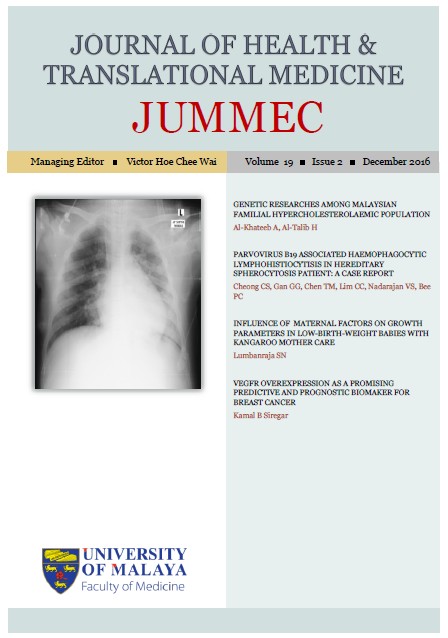VEGFR OVEREXPRESSION AS A PROMISING PREDICTIVE AND PROGNOSTIC BIOMARKER FOR BREAST CANCER
DOI:
https://doi.org/10.22452/jummec.vol19no2.4Abstract
Background: The majority of breast cancer cases are presented in an advanced stage; hence, there is a need to have a biomarker that is able to function both as a predictive and prognostic tool for breast cancer. Since angiogenesis has been found to be closely related to the invasiveness of breast cancer, angiogenic marker such as vascular endothelial growth factor (VEGF) may be a promising marker for this cancer. Objective: The aim of this study is to determine the association between the VEGF receptor (VEGFR) expression with human epidermal growth factor receptor-2 (HER-2)/ neu and estrogen receptor (ER) /progesterone receptor (PR) expression in an attempt to clarify the role of VEGFR as a potentially novel predictive and prognostic biomarker for breast cancer. Materials and Methods: This study examined 40 tissue biopsies taken from patients diagnosed with breast cancer in H. Adam Malik Hospital Medan, Indonesia. Samples were analyzed by immunohistochemistry to determine the histopathology, grading, lymphovascular invasion and expression of VEGFR, HER-2/neu and ER/PR. Association between dependent and independent variables was conducted using chi-square test and logistic regression. Results: The majority of the cases in this study were infiltrating ductal carcinoma (90%), in stage III (70%), and showed positive TIL (75%). VEGFR expression was found to be upregulated in 21 samples (52.5%). HER-2/neu was positive in 14 patients (35.0%) and ER/PR was positive in 22 patients (55%). The expression of VEGFR positively correlated with HER-2/neu expression (p= 0.002) and negatively correlated with ER/PR expression (p= 0.012). Conclusion: Overexpression of VEGFR is a potential valuable predictive and prognostic biomarker for breast cancer. Antagonising VEGFR may serve as the future target therapy for the disease.
Downloads
Downloads
Published
Issue
Section
License
All authors agree that the article, if editorially accepted for publication, shall be licensed under the Creative Commons Attribution License 4.0 to allow others to freely access, copy and use research provided the author is correctly attributed, unless otherwise stated. All articles are available online without charge or other barriers to access. However, anyone wishing to reproduce large quantities of an article (250+) should inform the publisher. Any opinion expressed in the articles are those of the authors and do not reflect that of the University of Malaya, 50603 Kuala Lumpur, Malaysia.


